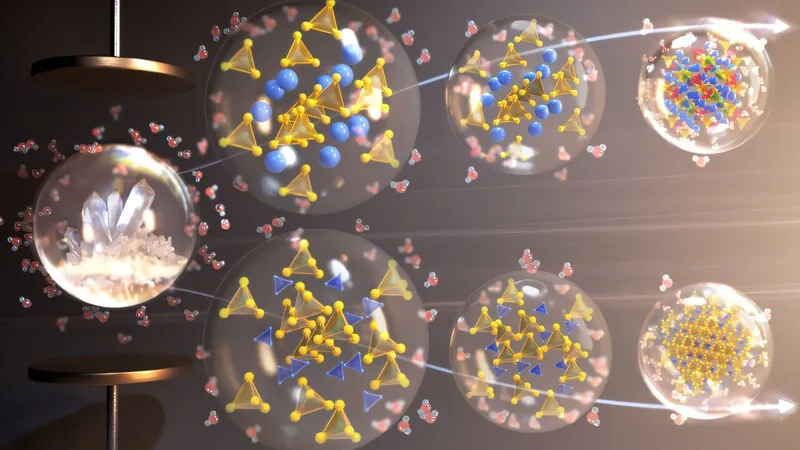
Scientific Breakthrough: How Molecular Symmetry is Revolutionizing Material Crystallization in Space
2024-10-31
Author: Jia
Scientific Breakthrough: How Molecular Symmetry is Revolutionizing Material Crystallization in Space
In a groundbreaking study aimed at discovering new materials suitable for extreme space environments, researchers from the Korea Research Institute of Standards and Science (KRISS) have made a significant breakthrough in understanding the crystallization pathways of substances. By meticulously observing the crystallization process, they can manipulate particle arrangements, enhancing material performance and controlling the formation of desired material phases.
For the first time, scientists have successfully observed the structural evolution of solute molecules in highly supersaturated aqueous solutions, revealing a crucial relationship between molecular symmetry and the formation of metastable material phases. This pioneering research, published in *Nature Communications*, marks a significant milestone in material science.
The phenomenon they studied ties back to a concept established over a century ago by German chemist Wilhelm Ostwald, known as Ostwald's step rule. This principle posits that supersaturated solutions tend to first convert into metastable states before forming thermodynamically stable phases. Various hypotheses have been proposed to explain this behavior, with the leading idea attributing it to alterations in the molecular structure of solutes within the solution.
Historically, verifying the molecular symmetry of solutes in highly supersaturated states has been an experimental challenge. Traditional methods often struggle to reach even double their known solubility limits. However, the innovative KRISS Space Metrology Group achieved remarkable success by utilizing a self-developed electrostatic levitation device, allowing them to create supersaturation levels exceeding four times the established solubility limit.
This breakthrough enabled them to observe firsthand how changes in molecular symmetry influence the crystallization pathways, paving the way for the formation of entirely new material phases. Senior research scientist Yong Chan Cho highlights the significance of this work, noting, "This achievement not only sheds light on the key factors governing material phase formation but also opens new avenues for creating materials tailored for extreme environments, including the unique challenges posed by space and advancements in biomedicine."
In a further testament to their advanced technology, the KRISS research group also achieved ultra-high-temperature conditions surpassing 4,000 K (3,726 °C) using their levitation device. They conducted precise measurements of the thermal properties of heat-resistant materials like tungsten (W), rhenium (Re), osmium (Os), and tantalum (Ta). These meticulous measurements are crucial for enhancing the safety and efficiency of materials used in applications such as space launch vehicles, aircraft engines, and nuclear fusion reactors.
Principal research scientist Geun Woo Lee elaborated on the implications of their findings: "With the electrostatic levitation device, we simulate microgravity akin to outer space, allowing us to precisely measure the thermophysical properties of materials. Major aerospace nations are increasingly using this technology to conduct essential experiments on the ground, cutting costs while boosting research efficiency."
Looking ahead, the KRISS research group aims to create an integrated measurement platform capable of accurately assessing material properties under extreme conditions, including ultra-high temperatures, supersaturation, and ultra-high pressures. This advance could herald a new era of innovation in material development, promising exciting possibilities in the realms of aerospace, bioengineering, and beyond. Don’t miss out on the future of material science—stay tuned for what this research could mean for humanity's endeavors in space exploration!

 Brasil (PT)
Brasil (PT)
 Canada (EN)
Canada (EN)
 Chile (ES)
Chile (ES)
 Česko (CS)
Česko (CS)
 대한민국 (KO)
대한민국 (KO)
 España (ES)
España (ES)
 France (FR)
France (FR)
 Hong Kong (EN)
Hong Kong (EN)
 Italia (IT)
Italia (IT)
 日本 (JA)
日本 (JA)
 Magyarország (HU)
Magyarország (HU)
 Norge (NO)
Norge (NO)
 Polska (PL)
Polska (PL)
 Schweiz (DE)
Schweiz (DE)
 Singapore (EN)
Singapore (EN)
 Sverige (SV)
Sverige (SV)
 Suomi (FI)
Suomi (FI)
 Türkiye (TR)
Türkiye (TR)
 الإمارات العربية المتحدة (AR)
الإمارات العربية المتحدة (AR)